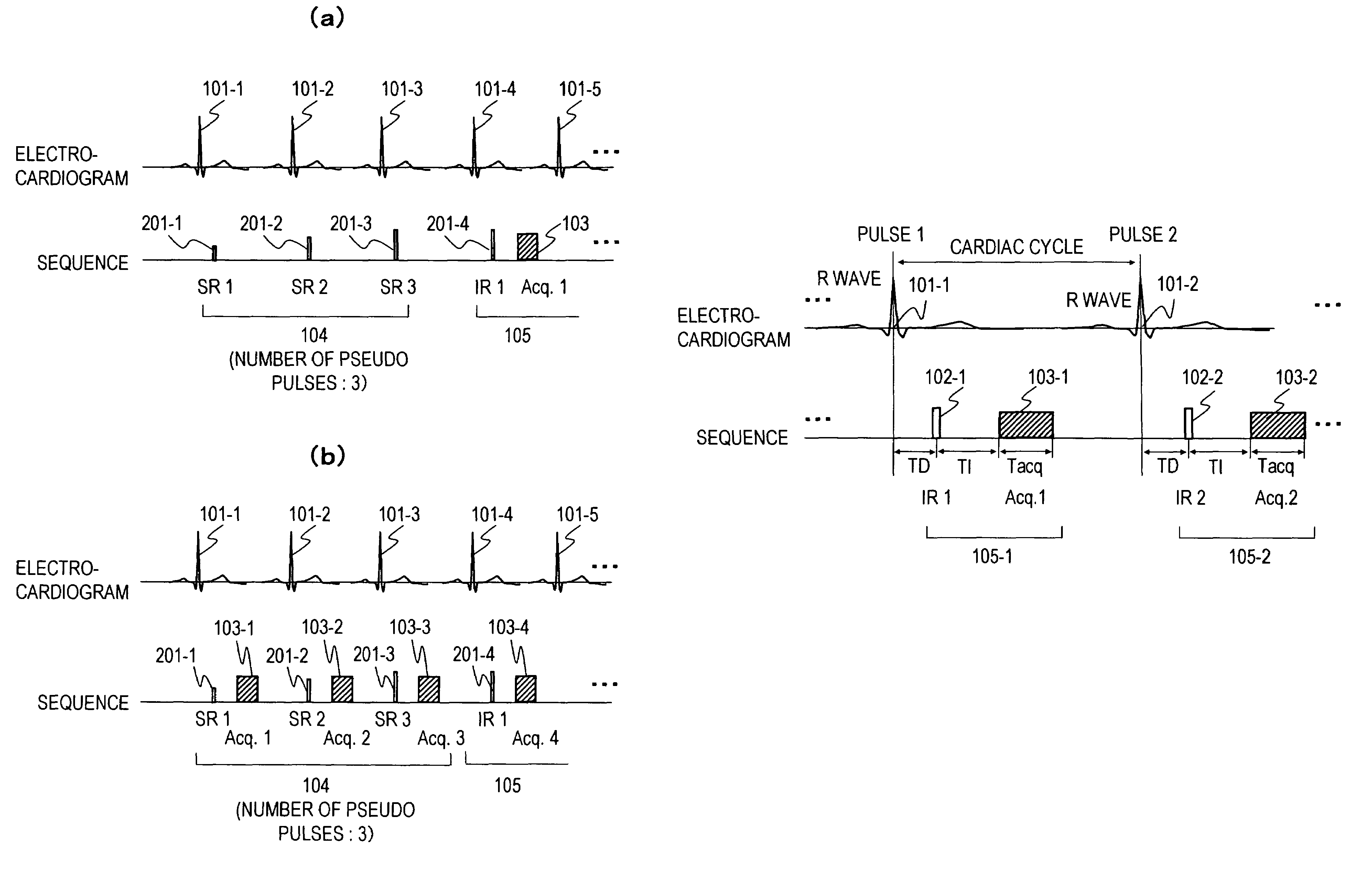Magnetic resonance imaging method and apparatus
a magnetic resonance imaging and magnetic resonance technology, applied in the field of magnetic resonance imaging methods and apparatuses, can solve the problems of reducing diagnostic accuracy, reducing diagnostic accuracy, and obtaining an insufficient effect in suppressing intensity variation or echo signals, so as to reduce the intensity variation of echo signals, prevent artifacts, and improve image quality
- Summary
- Abstract
- Description
- Claims
- Application Information
AI Technical Summary
Benefits of technology
Problems solved by technology
Method used
Image
Examples
first embodiment
[0047]A first embodiment of the present invention will now be explained. This embodiment is in a form to implement, at a start of imaging, a first pulse sequence to regulate the longitudinal-magnetization in a region including a desired imaging region of a subject prior to a second pulse sequence to measure an echo signal from the desired imaging region, where to take an image by use of a sequence for applying a pre-saturation pulse.
[0048]The present embodiment is explained of its content with an exemplification that the embodiment is applied for delayed contrast-enhanced imaging.
[0049]Based on the sequence shown in FIG. 4, explained first is the outline of a delayed contrast-enhanced imaging to be implemented by use of the MRI apparatus, noted before. This sequence is an example of a second pulse sequence, which, from now on, is referred to as the main measuring sequence. However, the invention is not limited to the main measuring sequence.
[0050]At first, a T1-reduced contrast agen...
second embodiment
[0072]A second embodiment of the invention is explained. The first embodiment was in the form to reduce the intensity variation of echo signals, constituting a cause of artifact, by applying the first pulse sequence at a start of imaging. However, where there is a change of the period of periodical physical movement of the subject, there is encountered the intensity variation of echo signals. For this reason, the second embodiment is in a form to insert and execute a first pulse sequence, that regulates the longitudinal-magnetization in a region including a desired imaging region of the subject, into a second pulse sequence, that measures an echo signal from the desired imaging region, immediately after a period change in the subject periodic physical movement of the subject.
[0073]Based on FIG. 3, explanation is made on one example of the present embodiment assuming an irregular pulse, as an example there is a change in periodic physical movement. Here, it is possible to determine w...
third embodiment
[0080]A third embodiment of the invention is explained. This embodiment is in a form that, in such a case that a desired imaging region is temporarily moved due to a physical movement of the subject, when the desired imaging region comes back to the former position, a first pulse sequence, for regulating the longitudinal-magnetization in a region including the desired imaging region, is inserted and performed in a second pulse sequence for measuring an echo signal of from the desired imaging region.
[0081]Based on FIGS. 6 and 7, explanation is made on one example of the present embodiment assuming respiratory movement, as an example that a desired imaging region changes in position due to a periodic physical movement.
[0082]In the case there is a difficulty for the subject to stop his / her breath, imaging is desired to perform with free respiration. However, with free respiration, the heart moves in position associatively with vertical movement of the diaphragm. For this reason, there ...
PUM
 Login to View More
Login to View More Abstract
Description
Claims
Application Information
 Login to View More
Login to View More - R&D
- Intellectual Property
- Life Sciences
- Materials
- Tech Scout
- Unparalleled Data Quality
- Higher Quality Content
- 60% Fewer Hallucinations
Browse by: Latest US Patents, China's latest patents, Technical Efficacy Thesaurus, Application Domain, Technology Topic, Popular Technical Reports.
© 2025 PatSnap. All rights reserved.Legal|Privacy policy|Modern Slavery Act Transparency Statement|Sitemap|About US| Contact US: help@patsnap.com



